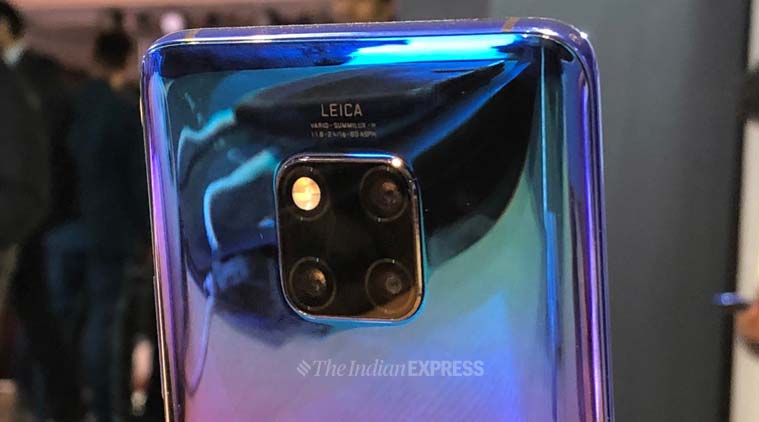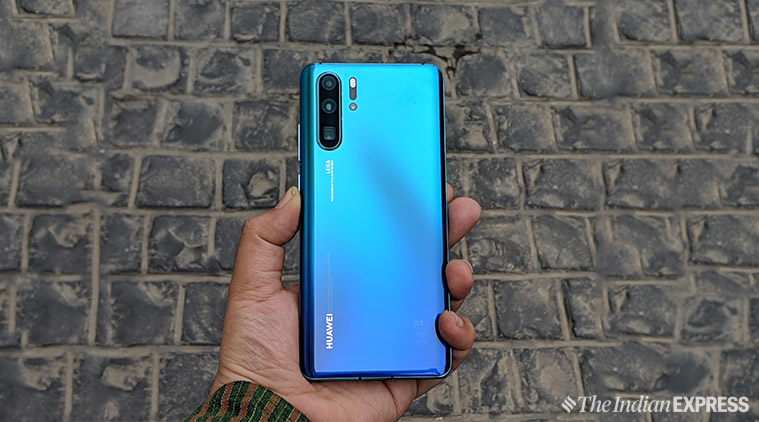- India
- International
As August 19 deadline nears, Huawei is closer to HarmonyOS, but that might not be answer to Android
While HarmonyOS is technically capable of running on phones, the company said it would still like to continue with Android as the default operating system of choice on its smartphones. The switch to Harmony would only happen if Huawei was forced to abandon Android.
 Richard Yu, CEO of Huawei’s Consumer Business Group, during the launch of HarmonyOS at the company’s first annual developer conference in China. (Image credit: Honor India)
Richard Yu, CEO of Huawei’s Consumer Business Group, during the launch of HarmonyOS at the company’s first annual developer conference in China. (Image credit: Honor India)
When last week Huawei announced its proprietary Harmony operating system at a developers’ conference held in China, many thought it was an alternative to Android. As it turned out, Harmony [known as HongMeng in Chinese] is not an operating system to replace Android on phones, but rather is designed to work on devices ranging from smart TVs to tablets to smartwatches.
While HarmonyOS is technically capable of running on phones, the company said it would still like to continue with Android as the default operating system of choice on its smartphones. The switch to Harmony would only happen if Huawei was forced to abandon Android.
But Huawei did not offer many details on how the transition from Android to HarmonyOS would take place and when. At the moment, it’s confirmed that the company’s existing smartphones such as the Mate 20 Pro and Honor 20 Pro will be getting the next version of Google’s Android Q operating system, but it’s not confirmed what will happen to future devices. Knowing that its temporary 90-day reprieve on ban is going to end on August 19, Huawei has not confirmed what would be its plan of action, if it faces a total ban next week.
‘Huawei HarmonyOS is not an alternative to Android yet’
Huawei has ambitions and scale to make HarmonyOS a viable operating system in the future, but it would be naive to call it an alternative to Google’s Android yet. And Huawei knows it well and perhaps the reason it never showed a working smartphone running HarmonyOS at its developer conference in Dongguan, China.
Look, rolling out the OS is not an issue for a massive company like Huawei. But the bigger challenge is apps as well as developer support and right now both are missing. Maybe the reason why Huawei keeps repeatedly saying it doesn’t want to abandon Android on smartphones. Because it knows no one will buy a phone if it lacks popular apps and services.

“Huawei’s overseas market could meet serious challenges if it decides to switch to HarmonyOS directly, Mo Jia, an analyst with Canalys’ Shanghai office told indianexpress.com over mail. “As the ecosystem is not ready, the consumers are not ready either. If Huawei is not forced to do so, I don’t think it wants to move away from Android at this time,” he said.
At its developer conference, Huawei stated that HarmonyOS will be “first used for smart devices like smartwatches, smart screens, in-vehicle systems and smart speakers.” The company clearly understands that its home-made operating system is not fully functional to be rolled out on smartphones.
“Huawei needs to showcase its plan-B, as the US could ban Huawei, not only from the component side, but also the software side at any time. Harmony OS, to Huawei’s smartphone business, is surely a plan-B right now,” said Jia.
 Huawei has ambitions and scale to make HarmonyOS a viable operating system in the future, but it would be naive to call it an alternative to Google’s Android yet.
Huawei has ambitions and scale to make HarmonyOS a viable operating system in the future, but it would be naive to call it an alternative to Google’s Android yet.
Developing an operating system is one thing and creating an ecosystem around it is another. A lot goes into an operating system other than the basic framework and UI, like apps, developer support, security and privacy, localisation, and App Store.
“The HarmonyOS on Huawei’s other connected devices as smart displays, wearables or smart speakers could help Huawei gather users’ first-hand feedback and consistently improve it to a better version. In the future, it could eventually become a challenger for Google’s Chrome OS, or, if Huawei’s forced to do so, even the Android OS,” Jia adds.
Ben Wood, chief of research at CCS Insight, explained that Huawei had no option but to focus on areas beyond the smartphone such as TVs, watches, IoT devices and more. These are the focus areas where the company can make the most progress initially.
“It [Huawei] wants to continue using Android for smartphones if it can get a resolution to the current issues it has as a result of being added to the US’s Entity List. Should this not get resolved then it will see to make Harmony work on smartphones, but beyond China, it will be a very tough challenge to drive adoption of a new OS given Android and iOS’s current dominance,” he said.
Also read: Galaxy Note 10+ to Motorola One Action: Top 5 sought after smartphones with unique features
‘Developer support crucial for the success of HarmonyOS’
Harmony is a modern operating system and will be open-source, which means other third-party manufacturers will be able to use it. But what separates Harmony from Android and iOS is that it’s a microkernel-based operating system, which is lag-free and will have a “Deterministic Latency Engine” to help the software recognise which tasks to prioritise in order to achieve fast performance. Google is also working on a brand new OS called Fuchsia with similar aims.
As an operating system, Harmony will be capable of adapting to different screen layouts and interactions. This simply means that developers need to code their apps once and they should work across various types of devices. It all sounds great on paper, but not many developers would be in favour of this approach.
“App development is always challenging and although companies can deliver tools to make it possible to scale apps across different screens and devices it typically requires additional work to ensure it works correctly. There is little doubt Huawei will make a big investment to make its dev tools as effective as possible, but we will only learn the true extent of the challenges once the platform is widely available across many devices,” Wood said.
 Huawei can succeed with HarmonyOS in China where it has both market share and influence.
Huawei can succeed with HarmonyOS in China where it has both market share and influence.
The problem with HarmonyOS is that Huawei not even once mentioned that it wants to compete with Google on the mobile operating system front. This raises serious doubts on Huawei’s intent to project Harmony OS as the third viable mobile operating system after Google’s Android and Apple’s iOS.
“HarmonyOS can be evolved to be used on smartphones, the challenge is how Huawei gets broad support for the platform on a global basis, particularly with regards apps where developers can get the most reward from making Android and iOS solutions,” Wood explained.
Huawei can succeed with HarmonyOS in China where it has both market share and influence. Developers would be more than happy to make apps for the new operating system since Google services are banned. Jia believes if Huawei switches to Harmony OS in China, the move will be accepted by consumers within a short time, provided the OS manages to offer and experience similar to Android.
From the strategy point of view, HarmonyOS makes a lot of sense for Huawei in its home market, because since the OS is open source, the Chinese vendors may like to ship their phones with the new OS over Android. Right now, Chinese smartphone vendors like Xiaomi and Vivo need to develop their own UIs over the top of Android OS.
But there is no guarantee whether third-party developers from America and Europe would jump in and create apps for HarmonyOS. The market for Android and iOS is big enough that many developers don’t see a need for a third OS. If that’s the case, then Huawei’s job becomes even more difficult to convince developers behind Instagram and Spotify to bring their apps to HarmonyOS. Without an ecosystem of apps and developers, HarmonyOS will meet the same fate as Samsung’s Tizen OS and Microsoft’s Windows Mobile.
Wood believes that if Harmony OS gets some traction it is highly likely American app developers and big web players such as Facebook and Google will seek to support the platform. However, it all depends on what they are allowed to do under the terms of the Entity List restrictions, or whether the Entity Listing is changed.
Jia says a lot will depend on how the situation is going to be after August 19, and whether Huawei must use its plan-B. “The American developers’ support would be highly linked with this risk as well. If Huawei got banned by the US totally, not allowed to get any support from the US companies including Google and Facebook, as well as the developers there, its overseas smartphone business could meet a very fundamental challenge, even it managed to switch all of its component supplies out of the US, and install Harmony OS on smartphones.”
Also read: Samsung Galaxy Note 10+ hands-on: This premium flagship feels just right
‘No clarity on Huawei Mate 30 Pro software’
Wood doesn’t think that Huawei will launch the flagship Mate 30 series with Harmony OS. “It might be too early and furthermore I’m certain Huawei would rather offer these devices with Android if a resolution to the current situation can be found.”
Jia too is of the opinion that Huawei will skip Harmony OS on the Mate 30 Pro. Instead, he believes that the company will like to launch an entry-level smartphone with Harmony OS first. This will allow Huawei to get some sort of feedback which will help make changes in the 2.0 version of HarmonyOS.
‘Future of Huawei still uncertain’
A question mark still hangs over the fate of Huawei, the world’s largest telecommunications company and the second-largest supplier of smartphones next to Samsung and ahead of Apple.
The US Commerce Department in May had placed Huawei on its entity list, which barred the Chinese company from buying American-based technology products and services including Google’s Android OS for smartphones and Microsoft’s Windows OS for laptops. Although US President Donald Trump said at the Osaka G20 summit that some restrictions would be lifted against Huawei, the current situation remains unclear.
 At its developer conference, Huawei stated that HarmonyOS will be “first used for smart devices like smartwatches, smart screens, in-vehicle systems and smart speakers.”
At its developer conference, Huawei stated that HarmonyOS will be “first used for smart devices like smartwatches, smart screens, in-vehicle systems and smart speakers.”
Huawei may see Harmony OS as a Plan B, but in reality, it isn’t a rival to Google’s Android, the world’s most dominant mobile operating system. Harmony might look like a next-generation operating system, but without apps and developer support, Huawei’s ambitious move seems doomed. If the restrictions on Huawei aren’t lifted on August 19, the company will be forced to launch smartphones with an unfinished OS that lacks popular apps, or no apps at all.
Investors and tech pundits have set their eyes on August 19, the day when a 90-day short-term reprieve that allowed US companies to sell key components and software to Chinese tech giant Huawei expires. With the US-China trade war getting ugly and Huawei being caught between the two superpowers, the future of China’s biggest tech company is uncertain.
Apr 27: Latest News
- 01
- 02
- 03
- 04
- 05










































